 | |
| Company type | Part of state-owned enterprise |
|---|---|
| Industry | Rail transport in New Zealand Ferry transport |
| Founded | 1962 |
| Headquarters | Wellington, New Zealand |
| Area served | Cook Strait, New Zealand |
| Services | Inter-island ferries |
| Parent | KiwiRail |
| Divisions | Interislander (passenger) Interislander Freight (freight) |
| Website | www.greatjourneysofnz.co.nz |
Interislander is a road and rail ferry service across New Zealand's Cook Strait, between Wellington in the North Island and Picton in the South Island. It is owned and operated by state-owned rail operator KiwiRail. Three roll-on roll-off (RORO) vessels operate the 50-nautical-mile (93 km; 58 mi) route, taking about three hours to complete the crossing.
The inter-island rail ferry service began in August 1962 by the New Zealand Railways Department (NZR). The service primarily provided a RORO rail link between its North and South Island networks, allowing NZR to compete directly with coastal shipping companies for inter-island freight. It also provided the first RORO road link between the two islands, which saw the Wellington to Picton ferries compete with, and then completely replace, the Union Company's Wellington–Lyttelton ferry service. Today, the Interislander service is still well patronised despite competition on the Wellington–Picton sea route with Bluebridge and from airlines, carrying around one million passengers and 230,000 vehicles per year on 5,500 sailings.
In 2017, Interislander became part of The Great Journeys of New Zealand, a new tourism brand created by KiwiRail to unite its four scenic passenger services: Interislander, Northern Explorer, Coastal Pacific and the TranzAlpine.
History
Introduction
Before 1962, the North Island and South Island rail networks were not connected, and the New Zealand Railways Department (NZR) struggled to compete with ships for inter-island transport. In the days before containerisation, rail freight between the islands had to be railed in a wagon to Wellington, unloaded and transferred onto a ship to Picton or Lyttelton, then loaded into another wagon before being railed the rest of the way. The Union Steam Ship Company (USSC) ran an overnight ferry between Lyttelton and Wellington using steamers. NZR also contracted SAFE Air to run its Rail Air airfreight service for freight between the islands, from Paraparaumu to Blenheim, but this was limited to aircraft payloads.
The decision to start a rail ferry was made in 1958 by the Cook Strait Transport Enquiry Committee. The enquiry was set up following Union Steam Ship's decision to withdraw the unprofitable Tamahine, built in 1925. NZR was officially reluctant to compete with USSC for inter-island traffic, but supplied the New Zealand Railway Officers' Institute with information to put to the enquiry.

The Cook Strait Inter-Island Rail and Road Service (as it was known) started on 11 August 1962 with the roll-on roll-off ferry GMV Aramoana. The service dramatically increased efficiency, since freight could stay in the same wagon the whole journey, reducing time and money. Aramoana took just 3 hours 20 minutes to cross Cook Strait, dramatically decreasing the time between the two islands for cars and passengers - Wellington to Christchurch travel time was reduced from 11 hours on the USSC ferry to nine hours by NZR ferry and road. The initial service was one sailing each way per day, Wellington to Picton in the morning and Picton to Wellington in the afternoon. The new service led to the decline of NZR's Rail Air service, which saw a dramatic drop in airfreight.
The service was an immediate success, although it was criticised for high prices. At NZ£ 9 10s one way for a family of four and a car up to 4.04 m (equal to NZ$395 in 2016 dollars,) many people thought the service was overpriced for a state-operated service. Nevertheless, it was a cash cow for NZR - in the 1963-64 financial year, it contributed £535,000 of the NZR's £538,500 working profit.
The service expanded with the addition of Aranui in 1966, MV Arahanga in 1972 and Aratika in 1974. The Union Company responded to the competition by converting TEV Maori to take roll-on roll-off (RORO) road traffic and ordering a new RORO ship, TEV Wahine. However, the resurgence was short-lived: on 10 April 1968, Wahine foundered at the entrance to Wellington Harbour during a storm, resulting in 53 deaths. By the time replacement ship TEV Rangatira entered service in 1972, competition from the Cook Strait ferries and increased competition from air travel, especially following the National Airways Corporation's introduction of the Boeing 737 in 1968, saw the Wellington-Lyttelton service become uneconomic. The Union Company withdrew in 1974, and after two years under the Ministry of Transport, the service was cancelled in September 1976. In 1982 Arahura joined the fleet to replace the ageing Aramoana and Aranui. The faster Arahura reduced the time across Cook Strait by 20 minutes to three hours.
Initially, USSC operated the ferries on NZR's behalf. This changed in 1970 when the Minister of Railways, Peter Gordon, announced that NZR would be forming its own maritime service to operate the inter-island ferries.
SeaRail and The Interislander
When the New Zealand Railways Corporation (the successor to the Railways Department) was restructured in 1982, the service was renamed "SeaRail". In 1989, it was renamed the Interisland Line, and the service became known as The Interislander. The fleet was upgraded with improved facilities and an updated livery whose logo incorporated Pelorus Jack. In 1991, New Zealand Rail Ltd, including the Interisland Line, was spun off from the Railways Corporation. In 1993, New Zealand Rail Ltd was privatised and became Tranz Rail in 1995. In 1999, Tranz Rail leased DEV Aratere, and between 1999 and 2001 disposed of Arahanga and the Aratika.
In 1990, the Interislander launched an advertising campaign with the jingle "Cruisin' on the Interislander (Sailing to the Other Side)" written and performed by Wellington band The Waratahs. The jingle became iconic, with a second jingle "Easy Come, Easy Go (Cruisin' on the Interislander)" by the Waratahs released in 1998.
In 2004, Toll NZ bought out Tranz Rail, and the Interisland Line was renamed the Interislander. Both ships were repainted in a new livery, with a fern replacing Pelorus Jack on the funnel - he moved to the hull with the logo. In 2005, Toll leased Challenger, which in 2007 was renamed MV Kaitaki. Kaitaki was the first Interislander ferry without a rail deck, and the first with a bow door (all the other ferries were stern boarding).
KiwiRail
On 1 July 2008, the New Zealand Government purchased Toll NZ, including Interislander, becoming part of KiwiRail.
In 2011, Aratere was lengthened by adding a 30-metre midsection to increase its capacity.
In November 2012, Interislander staff threatened strike action over the upcoming Christmas period, demanding better wages. Owner KiwiRail responded with a lock-out notice. Freight company Mainfreight slammed the union's actions as "bloody disruptive".
In November 2013, Aratere snapped a drive shaft and lost a propeller in the Cook Strait. Interislander chartered MS Stena Alegra to help with the peak summer period while Aratere was under repair. In December 2014, it was announced Stena Alegra would be chartered long-term to replace the ageing Arahura. Arahura last sailed on 29 July 2015, and the Stena Alegra, refurbished and renamed Kaiarahi, entered service in September 2015.
Fast ferry services
The Lynx was the Interislander's fast ferry service across Cook Strait. Pressured by Christchurch businessman Brooke McKenzie and his ill-fated Sea Shuttles NZ fast ferry service, the Interisland Line chartered the HSC Condor 10 to operate a fast service across the strait for the 1994/95 summer. The "Vomit Comet", as it was sometimes dubbed, was an initial success, taking half the time of the regular Interislander ferries. Condor 10 returned to serve as The Lynx every summer until 1999, when it was replaced by the HSC Condor Vitesse for the 1999/2000 summer. A year-round service was started in 2000 with HSC Normandie Express, which was replaced in 2003 by HSC Incat 046.
In 1994, speed restrictions were imposed in Wellington Harbour to reduce wash and protect ships berthed at Aotea Quay, and in May 2000 an 18-nautical-mile-per-hour (21 mph; 33 km/h) speed limit was imposed on all ships in the Marlborough Sounds after residents complained of shoreline damage caused by the ferries. By 2002, The Lynx took 2 hours 15 minutes to complete its journey. This was only a 45-minute advantage over the Arahura and Aratere, which had the advantage of being able to operate in swells above The Lynx's limit of 4.0 metres (13.1 ft), which were common in Cook Strait and frequently caused cancellations. The Lynx ceased operation in 2003.
Proposed ferry terminal redevelopment
Interislander planned to introduce new hybrid electric ferries that were 30 m (98 ft) longer than those currently in operation. In 2020, following two years of discussion with stakeholders, Greater Wellington Regional Council announced that it had chosen Kaiwharawhara as its preferred site for a new ferry terminal. The terminal was to be built on land owned by KiwiRail, CentrePort and the NZ Transport Agency. The new terminal was to accommodate the larger ferries and replace the two separate terminals currently used by StraitNZ and the Interislander. In addition, CentrePort would be able to make changes to the layout of its other port operations. The plan included a wharf about 250 m (820 ft) long, a ferry terminal building, changes to road, rail and pedestrian access, and marshalling and loading areas. The panel that approved the project called it the biggest rail capital project since World War 2.
In 2020 KiwiRail proosed to build a KiwiRail-only central city terminal near King's Wharf; to replace the combined Kaiwharawhara ferry terminal plan. This KiwiRail-only terminal might later be expanded to include other users like StraitNZ, but this plan was abandoned a it was opposed by almost every other harbour user and the city and regional councils. KiwiRail claimed that the Kaiwharawhara site was an earthquake risk because of the Wellington Fault Line. Initial cost estimates in 2019 were $390 million to $730 million, and it could be built by the mid-2020s for the new ferries.
Proposed ferry replacements 2019-2024
As at 2024, all Interislander vessels were built in the 1990s (1995 or 1998). All vessels were scheduled to be replaced by two identical rail capable vessels by 2024.
A revised plan was that much larger rail–equipped ferries, designed by a leading ship's architect, would be introduced in 2024 and 2025. A NZ$551m contract for the ferries was awarded to Hyundai Mipo Dockyard in 2021, with deliveries in 2025 and 2026. The new ferries were to carry twice as many passengers and nearly double the number of trucks and other vehicles with triple rail capacity - 40 wagons on each ship.
Cancellation of ferry replacements
Following the 2023 New Zealand general election, the Minister of Finance Nicola Willis declined KiwiRail's request for an additional NZ$1.47 billion to replace its ageing Interislander ferry fleet. While the outgoing Labour Government had approved plans to buy two new (and larger) ferries (but in February 2023 had refused a request for $2.6 billion of extra funding), the incoming National-led coalition government regarded the project as too costly; with Willis likening the proposed ferries to Ferraris, and stating that the Government would be looking for cheaper alternative ferries. Willis said that only 21% of the total cost was for the ferries, with most for port redevelopment. Initially two texts were sent to South Korea before the pending announcement. The chairman of the Greater Wellington Regional Council, Daran Ponter was aware of the extent of the port redevelopment proposed (as was his Picton counterpart), and had expressed concern as the port companies would be expected to finance part of the work.
The Government's decision to scrap the ferry replacement project was criticised by Labour's finance spokesperson Grant Robertson and several unions including the Maritime Union of New Zealand, the Rail and Maritime Transport Union, the New Zealand Merchant Service Guild and the Aviation and Marine Engineers Association.
Fleet
Current fleet
| Name | Image | Shipyard | Launched | Entered service | Port of registry | Tonnage | Notes |
|---|---|---|---|---|---|---|---|
| Aratere | 
|
1998 | 1999 | 17,816 GRT | Aratere is a rail ferry, carrying 27 rail wagons on the lower vehicle deck and road vehicles on the upper vehicle deck. | ||
| Kaiarahi | 
|
1998 | 2015 | 22,152 GT | Built in 1998 as Dawn Merchant. Chartered temporarily in 2014 as the Stena Alegra while Aratere was out of service. Chartered long-term in 2015, with the vessel being renamed Kaiarahi. | ||
| Kaitaki | 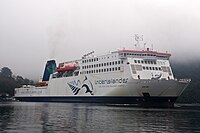
|
1995 | 2005 | 22,365 GT | Built in 1994 as Isle of Innisfree. Chartered in 2005 as Challenger, with the vessel being renamed Kaitaki in 2007. Purchased in 2017, with her home port moving to Wellington. |
Historic fleet
| Name | Image | Shipyard | Launched | Entered service | Retired from service | Tonnage | Notes |
|---|---|---|---|---|---|---|---|
| Aramoana | 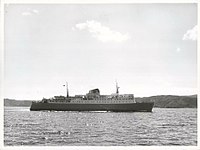
|
1961 | 1962 | 1985 | 4,160 GRT | ||
| Aranui | 
|
1965 | 1966 | 1985 | 4,160 GRT | ||
| Arahanga | 
|
1972 | 1972 | 2001 | Built as a cargo ferry with four tracks for railway wagons and additional capacity for road trucks. Originally designed to only carry 40 passengers, it was refitted in 1984 to carry 100. | ||
| Aratika | 
|
1974 | 1974 | 1999 | 9,035 GT | Originally freight only. Converted to passenger use in 1976. | |
| Purbeck | 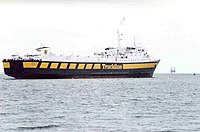
|
1978 | 2003 | 2006 | 6,507 GT | ||
| Arahura | 
|
1982 | 1983 | 2015 | 13,621 GT | ||
| Condor 10 "The Lynx" | 
|
1992 | 1994 | 1999 | 3,240 GT | ||
| Condor Vitesse "The Lynx" | 
|
1996 | 1999 | 2000 | 5,007 GT | ||
| Normandie Express "The Lynx" | 
|
2000 | 2000 | 2002 | 6,581 GT | ||
| Incat 046 "The Lynx" | 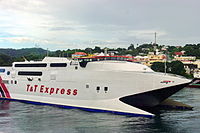
|
1997 | 2002 | 2003 | 5,707 GT | ||
| Valentine | 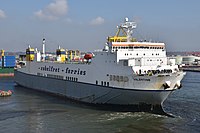
|
1999 | 2021 | 2023 | 23,987 GT | Roll-on/roll-off cargo ship chartered in 2021, purchased in 2022. Sold in 2023 to Greece, and reported at Perama in 2024. |
References
- "The Journey - Interislander". Archived from the original on 21 December 2019. Retrieved 28 June 2017.
- "Kiwirail 2010-2011 Annual Report" (PDF).
- "KiwiRail launches the Great Journeys of New Zealand at TRENZ 2017". Scoop.
- ^ "'The floating bridge' - Cook Strait ferries". New Zealand History online. Retrieved 21 August 2011.
- Leitch & Stott 1988, p. 153.
- "Interislander 50th Edition". Issuu. Retrieved 23 December 2018.
- "Ship Fact Sheet – Tamihine (1925)" (PDF). P&O Heritage. Retrieved 23 May 2019.
- ^ Hurst, Tony (April 2018). "Main North Line". New Zealand Railway Observer. 348: 5.
- "Tamahine Arrives, Evening Post". paperspast.natlib.govt.nz. 16 December 1925. Retrieved 23 December 2018.
- ^ Crossing the Cook Strait Ships Monthly July 2022 pages 62-66
- Bromby 2003, p. 152.
- "Drive inter-island brochure - nzhistory.net.nz". Retrieved 21 November 2010. The fares have been corrected for 1962, when the New Zealand pound was still in use.
- "New Zealand CPI Inflation Calculator - Reserve Bank of New Zealand". Retrieved 16 November 2016.
- "Wellington Ferry Service Ends - nzhistory.net.nz". Retrieved 12 January 2012.
- McGavin, T. A. (Summer 1970–71). "Rail Ferry Management". New Zealand Railway Observer (126): 146. ISSN 0028-8624.
- Cook Strait Rail Ferries Archived 27 July 2009 at the Wayback Machine - New Zealand Maritime Record
- "Cruising on the Interislander - The Warratahs | Commercial | NZ On Screen". www.nzonscreen.com. Retrieved 1 October 2024.
- "Interislander strike rests on new vote". 3 News NZ. 27 November 2012.
- "Interislander strike talks continue". 3 News NZ. 26 November 2012.
- "Mainfreight condemns Interislander strike". 3 News NZ. 23 November 2012.
- ^ "The "Vomit Comets" - Fast ferries on Cook Strait - NZHistory.net.nz". Retrieved 21 November 2010.
- Environment Co-ordination Department Report – June 2003 [Report] (PDF). Wellington, New Zealand: Greater Wellington Regional Council. 2003. p. 22.
- ^ Knell, Conor; Fuller, Piers (25 January 2023). "Wellington harbour to get new wharf, ferry terminal building". Stuff. Archived from the original on 1 June 2023. Retrieved 1 June 2023.
- "Kaiwharawhara makes cut as site for new multi user ferry terminal". Greater Wellington Regional Council. 24 February 2022. Archived from the original on 1 June 2023. Retrieved 1 June 2023.
- "Kaiwharawhara Wellington Ferry Terminal Redevelopment". Ministry for the Environment. 11 February 2022. Archived from the original on 1 June 2023. Retrieved 1 June 2023.
- "KIwiRail backs down on plan for controversial Wellington harbour ferry terminal". Stuff New Zealand. 17 December 2000.
- "Aratere ferry grounding just the latest problem to hit Interislander's ageing fleet". RNZ. 22 June 2024. Retrieved 22 June 2024.
- "Three Interislander ferries to be replaced by two rail-ready vessels". Stuff. 21 January 2019. Retrieved 4 October 2020.
- "next step for new generation interislander ferries".
- "Interislander Signs Up for a New Era of Cook Strait Ferries". The Maritime Executive. Retrieved 1 September 2024.
- ^ "Interislander signs up for a new era of Cook Strait ferries". KiwiRail. Retrieved 2 July 2021.
- New Era for Cook Strait Ferries Ships Monthly August 2021 page 6
- "Interislander ferry fleet project to wind down after being denied further government funding". Radio New Zealand. 13 December 2023. Archived from the original on 13 December 2023. Retrieved 15 December 2023.
- "Two texts sent within an hour of announcement". The Post, Wellington. 4 September 2024.
- "Rough seas ahead for Cook Strait ferry plans". Sunday Star-Times, Wellington. 3 November 2024.
- Palmer, Russell (14 December 2023). "National, Labour firing broadsides after Cook Strait ferry project founders". Radio New Zealand. Archived from the original on 14 December 2023. Retrieved 15 December 2023.
- "Finance minister should resign over scrapping of Interislander upgrade funding - unions". Radio New Zealand. 13 December 2023. Archived from the original on 14 December 2023. Retrieved 15 December 2023.
- "KiwiRail leases additional ferry 'The Valentine' as demand on Cook Strait freight grows". Newshub. Retrieved 20 September 2022.
- Hunt, Tom (12 September 2022). "Leased freight ferry Valentine permanently added to Interislander fleet". Stuff. Retrieved 20 September 2022.
- "Kiwirail to sell freight-only ferry just six months after buying it". RNZ. 19 June 2023. Retrieved 19 June 2023.
- "Interislander freight ferry to set sail for Greece after sale". NZ Herald. 20 September 2023. Retrieved 12 July 2024.
- "VALENTINE I". vesselfinder.com. 10 June 2024. Retrieved 12 July 2024.
Bibliography
- Bromby, Robin (2003). Rails that built a Nation: An Encyclopaedia of New Zealand Railways. Wellington: Grantham House. ISBN 1-86934-080-9.
- Leitch, David; Stott, Bob (1988). New Zealand Railways: The First 125 Years. Auckland: Heinemann Reed. ISBN 0-7900-0000-8.
External links
- Interislander (official site)
- Cook Strait rail ferries – New Zealand History, by Ministry for Culture and Heritage
| New Zealand inter-island and Cook Strait ferries | |
|---|---|
| Current Cook Strait Wellington-Picton ferries | |
| Former Cook Strait (Wellington–Picton) ferries | |
| Former inter-island (Wellington–Lyttelton) ferries | |
| Companies |
|
| Services | |
| Public transport in New Zealand | |
|---|---|
| By region | |
| Authorities | |
| Ticketing | |
| Major inter-regional services |
|
| Advocacy groups | |